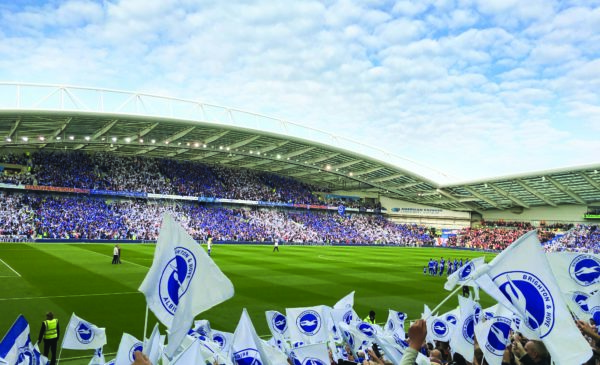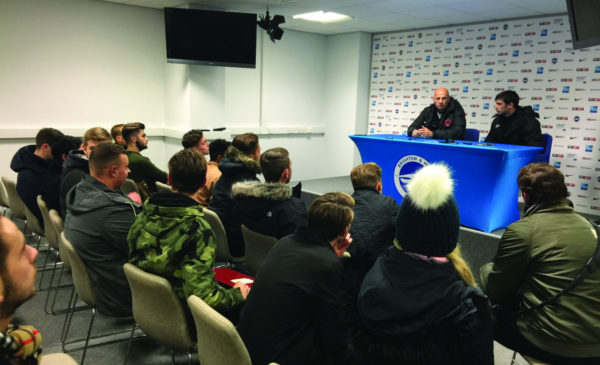This century has seen an unprecedented advancement of technology. Communication, research and social media have made it more accessible than ever to learn about your body and how to look after it. The nutrition industry has been a beneficiary of this evolution, the data available to dieticians, athletes and other professionals has equated to a higher percentage of athletes at all levels of sports’ pyramids being in prime physical shape. In this essay I will explore the history behind this advancement, the direct correlation it has with technology’s fruition, the current state of the nutrition industry, alongside first-hand research I have carried out into athletes that I know.
Sporting teams, at the elite level, has seen a drive for care to be taken over players’ physical and mental wellbeing over the last thirty to fourty years. It wasn’t uncommon in the 70s for a player playing in the highest tier of English football to have another job, football was a secondary. Now, alongside the commercialisation of the game, clubs have the resources to employ professionals to look after players’ dietary routines. Arsene Wenger, former Arsenal manager, could be seen as a pioneer for this drive. “One area that I have emphasised for many years (as early as the 1980s) that can help us achieve our performance goals is nutrition, an area that has grown in importance within the game.” (Wenger, 2019) It has been well documented that Wenger was a contributor for this new-found focus, stories include his meticulous instructions on how they should stir sugar in their coffee. “He then put the sugar in the coffee and moved it from left to right until the sugar had dissolved equally. Wenger had said, ‘if you must have sugar in your coffee, you must make sure the granules distribute evenly in your coffee so its absorbed evenly’.” (Cross, J 2015) In that era, it was probably alien for players to be controlled in such draconian way, but the results that ensued for that group of players supported the managers thorough methods. Another example within that group of Arsenal players which embodies the cultural shift of nutrition within the game is Tony Adams, “back in the 1980’s, and even through the early years of the Premier League in the 1990s, drinking was a part of the culture of the game” (Adams, 2018) who has spoken openly on his trouble with alcohol. Now, with a heavy emphasis on the control over players diets, the idea of players going to drink together after a game, seems outlandish. “I had been the social secretary, the old leader of the Tuesday club for the drinkers in the team. I guess the Tuesday club disbanded with the arrival of Arsene” (Adams, 2018). In modern society, with the power of social media, a player going out for a meal with his family and having a drink would likely be in a tabloid the next day. Players now have a responsibility to behave as professionals on and off the pitch, as the likelihood of them being exposed for not doing so is huge and it may hinder their performance on the pitch.
Speaking to Jay Baghuelou, who is a regular for Crystal Palace’s under 23’s side, the centre back opened up on the discipline he has to sustain to keep in shape. “The club gives us guidance but not a strict specific, diet. The nutritionist Kate tells us what we should be including in our diet”. Alongside professional advice, Jay has his own dietary routines, “on a training day I’ll have a bowl of porridge with some protein powder in, then I’ll get to training at 9 and there’s normally food there waiting like a banana or more porridge, so I’ll eat that, but I need it. I’m running about 10km a week at training so I’m not really looking at the food as ‘oh I have to eat more food’, I want the food because I know my body needs it. Then we’ll come in for lunch at training and eat at the canteen, I’ll have something like chicken and rice or a chicken wrap. Then I’ll go home and eat peanut butter on toast, then I’ll have dinner. I probably eat around five to six meals a day.” (Baghuelou 2021) Running 10km is nothing new for professional footballers, but the information available to them and nutritionists, has enabled them to be able to sustain that level of performance in an easier way than before. “I don’t go near dairy, if I drink milk it’ll be almond milk but apart from that I don’t go near dairy” (Baghuelou 2021), Jay’s emphasis on staying clear of dairy is well supported in the sports industry, it has been found that dairy includes high amount of sodium, sodium increases the risk of having cardiovascular problems (Murray-Ragg 2017). In a UEFA group statement on nutrition within sport, it was established that “A player’s nutrition should be periodised and personalised to meet their training and match demands and individual objectives.” (Collins 2018) Jay supported this claim, “it varies from player to player depending on their position and what their physical goals are, for me I am trying to get bigger, so I am trying to get in as much protein as possible.” Maintaining and gaining size is, obviously, crucial for a centre back in the early stages of their career, and protein is the key component for doing this. “When you eat protein, your body breaks the protein down into amino acids. Those amino acids are then used to repair and grow new muscle fibres. When you consume an adequate amount of protein, your body will experience something called a positive balance of nitrogen.” (Armstrong 2019). This is not a new phenomenon, for decades athletes have been aware of the muscle building properties of protein, but details which nutritionists can offer on when to eat your protein, to optimise these properties, has come with the development of technology and research. Jays nutritionist advises players to consume consume twenty to fifty grams of protein every two to four hours, which explains the need for five to six meals a day. It is also compulsory for players to drink a protein shake after every game they play. Quite the difference in rituals from Arsenals ‘Tuesday Club’ in the 90’s. The point being, that even at under 23 level, the depth within the detail which goes into the players’ nutritional regime seems unbelievably thorough when you compare it to how footballers lived their profession in the latter stages of the 20th century.
In an attempt to differentiate how Jay goes about his profession to someone in another field of sport, I interviewed a friend of mine, Connor, who has been going to the gym four to five times a week for around three years. In doing this I wanted to explore the differences and similarities between their diets, how they prepare on a game day and a rest day and if they use any supplementation to help with performance. Connor told me that he tends to eat more on training days (which are his ‘game days’, of sorts), before working out, to compensate for the amount of energy/calories he is burning. This is slightly to different to Jay, as he on game days tends to eat slightly less than usual, to feel lighter “I won’t volume eat too much before the game because I don’t want to be bloated.” (Baghuelou 2021) Trying to gain muscle mass while also remaining relatively lean, Connor ‘bulks’ to make optimum gains, then cuts to drop fat and stay lean, “I try not to bulk for too long, 2 weeks max. I will eat more meals, and snack less when I’m bulking, within region of 4/5 meals, this helps me get my macros in that I need in order to gain weight in the right way. From experience I’ve found loading up on 2-3 big meals, to not be as effective when bulking.”(D’Addio 2021). Jay, playing a more cardio based sport, would, by default, find it hard not to stay lean, because of the amount of calories burnt by running. However, one similarity between the two is the preference of volume meals over the mass in meals themselves, Jay told me how important it is for his body to consume this amount of food, “I’m consuming 5-6 meals a day every day, which will sound crazy to you, but my body needs it.” (Baghuelou 2021). In the cutting phase of Connor’s diet, he uses the intermittent fasting method, whereby you will fast for a certain window in each day, usually 16-18 hours, to help lose fat and stay less hungry. “I’ll eat 2-3 meals a day, I’ll snack on fruits, nuts, cereal bars, drinking plenty of water etc. This is all helps to keep the calories down and remain in a surplus to lose weight.” (D’Addio 2021) The two of them also have their personal experiences with supplements. Supplementation can provide athletes with nutrients they may not have consumed from their food, some also give athletes a boost before performing. Jay is given supplementation at certain stages of his games. “Before a game they’ll give us some caffeine tablets, then at half time we’ll have this protein performance gel which we’ll take. You can feel the effect of this because without you’ll get to 60-70 minutes and you can feel yourself dropping off, but with the caffeine and gel at half time it gets me through.” (Bagheulou 2021) Within the gym circles, there is a supplement called pre workout, weightlifters use this to enhance performance, it boosts endurance, energy and focus for a workout. Connor tends to stay away from these “I’ve used pre-workouts, however not consistently as heard it’s bad for heart rate. I usually just drink a coffee before working out when I feel I need one. I like to rely on my own body as an energy source, and not substances. I believe it’s all mental and a lot of substances aren’t always effective and aren’t cheap either.” (D’Addio 2021). This ‘placebo’ idea of these supplements is a valid idea which is shared by many, in a study carried out into the idea of placebo of supplements on cyclists, it was concluded that “once an individual believes that they have ingested a performance‐enhancing substance, several behaviours may be modified that can contribute to exercise performance” (Saunders 2017). This supports Connors claim. Body builders and weightlifters have also seen benefits from technological advancements. There are apps available now such as ‘MyFitnessPal’ where you can track your caloric intake, and calculators online where you can see how many calories you should be consuming to gain or lose weight. Connor told me he utilises these but still likes to “listen to his body”.
“Modern technology has had such a profound impact on sport that many athletes and coaches now consider information derived from technological advances to be invaluable.” (Liebermann 2010). The correlation in time period between the rapid advancement of technology and sports nutrition is no coincidence. Nutritionists, scientists and athletes have untold amounts of data to be able to interpret and apply to increasing the level of performance seen at the highest level of sport. The direct affect these developments have had on elite sport has been proven in various studies. “The English Premier League is arguably one of the most competitive Leagues in the world and, over the last decade, has undergone substantial change with the distances covered at high intensity and sprinting increasing by 30–50% and the number of passes rising by 40%” (Paul S Bradley et al 2015). “Total distance covered during a match was ~2 % lower in 2006–07 compared to 2012–13. Across 7 seasons, high intensity running distance and actions increased by ~30 %. Sprint distance and number of sprints increased by ~35 %. Players performed more passes and successful passes in 2012–13 compared to 2006–07.” (C Barnes et al – 2014). The numerous studies don’t include a definitive answer on what exactly switched for English football to increase it’s physical levels in such a significant manner, however what is obvious is that the professionalism of the game has been emphasised heavily in this century. “The physical and technical demands of elite football have increased in recent years, as have the financial implications of winning or losing. Training regimens have been adapted accordingly.” (Collins 2018). After the formation of ‘The Premier League’ the game underwent a steady cultural shift, whereby fans who were once labelled “hooligans” are now required to have a certain level of wealth to follow their team up and down the country. The relevance of this being, the commercialisation of the game has seen all individuals, from fans to owners, take the game more seriously, which has allowed for advancements in all departments in the game, leading to the sport being played, physically, at an unprecedented level. “As the EPL generates revenue in excess of £2–3 billion per season, lower ranked teams will ultimately miss out on sizable financial revenue that could impact on player recruitment and infrastructural development. Conversely, the rewards of finishing in the top rankings include eligibility to compete in European competition such as the UEFA Champions League (UCL) and Europa League (EL), which can bring both financial and sporting success to clubs, thus enabling further development.” (Bradley et al 2015). The problem being, these developments may make for a more monopolised sport, where institutions with more resources available, have a greater advantage on what is available to them, creating an unbridgeable gap between the top and the bottom.
Overall, the development of nutrition this century has been a reflection of the technological revolution we are living in. This has had a profound impact on the way athletes go about their profession. It has also derived for a higher level of intellect needed among staffrooms, creating more jobs. All this has ensued for a physical level across sports which is ever improving, leaving the question of what the physical limit can be for human beings, how advanced performance enhancing supplements can get and what further discoveries about human anatomy can be revealed.
2368 words
Bibliography
“Placebo in sports nutrition: a proof‐of‐principle study involving caffeine supplementation” -Saunders et al (2016)
Importance of nutrition in football: the coach’s perspective – Wenger, A (2019)
UEFA expert group statement on nutrition in elite football. Current evidence to inform practical recommendations and guide future research – Collins, J et al (2018)
The Evolution of Physical and Technical Performance Parameters in the English Premier League – Barnes, C et al (2014)
Advances in the application of information technology to sport performance – Liebermann, D et al (2010)
Tier-specific evolution of match performance characteristics in the English Premier League: it’s getting tougher at the top – Bradley, P et al (2015)
Sober, Football, My Story, My Life – Adams, T (2018)
13 Ways Consuming Dairy Products is Detrimental to Human Health – Murray-Ragg, N (2017)
Do Amino Acids Build Bigger Muscles? – Armstrong, B (2019)
Interviewees-
Jay Rich Bagheulou (2021)
Connor D’Addio (2021)








